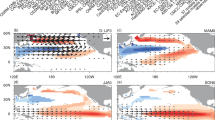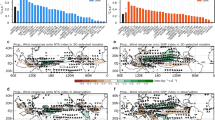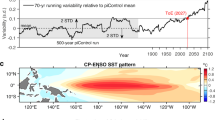Abstract
A majority of El Niño/Southern Oscillation (ENSO) events are preceded by the North Pacific Meridional Mode (NPMM), a dominant coupled ocean–atmospheric mode of variability. How the precursory NPMM forcing on ENSO responds to greenhouse warming remains unknown. Here, using climate model ensembles under high-emissions warming scenarios, we find an enhanced future impact on ENSO by the NPMM. This is manifested by increased sensitivity of boreal-winter equatorial Pacific winds and sea surface temperature (SST) anomalies to the NPMM three seasons before. The enhanced NPMM impact translates into an increased frequency of NPMM that leads to an extreme El Niño or La Niña. Under greenhouse warming, higher background SSTs cause a nonlinear evaporation–SST relationship to more effectively induce surface wind anomalies in the equatorial western Pacific, conducive to ENSO development. Thus, NPMM contributes to an increased frequency of future extreme ENSO events and becomes a more influential precursor for their predictability.
This is a preview of subscription content, access via your institution
Access options
Access Nature and 54 other Nature Portfolio journals
Get Nature+, our best-value online-access subscription
$29.99 / 30 days
cancel any time
Subscribe to this journal
Receive 12 print issues and online access
$209.00 per year
only $17.42 per issue
Buy this article
- Purchase on Springer Link
- Instant access to full article PDF
Prices may be subject to local taxes which are calculated during checkout





Similar content being viewed by others
Data availability
Data related to the paper can be downloaded from the following websites: HadISST v1.1, https://www.metoffice.gov.uk/hadobs/hadisst/; NCEP/NCAR Reanalysis, https://www.esrl.noaa.gov/psd/data/gridded/data.ncep.reanalysis.derived.html; CMIP5 database, https://esgf-node.llnl.gov/projects/cmip5/; CMIP6 database, https://esgf-node.llnl.gov/projects/cmip6/. A detailed reference and DOI for each CMIP6 model are provided in the Supplementary Information. The CAM3.1-RGO model experiment data are available from the corresponding authors on request.
Code availability
Codes for calculating MCA and NPMM pattern are publicly available via Zenodo at https://doi.org/10.5281/zenodo.5147938 (ref. 57). All other codes are available from the corresponding author on request.
References
Cai, W. et al. Butterfly effect and a self-modulating El Niño response to global warming. Nature 585, 68–73 (2020).
Cai, W. et al. Climate impacts of the El Niño–Southern Oscillation on South America. Nat. Rev. Earth Environ. 1, 215–231 (2020).
Chiang, J. C. H. & Vimont, D. J. Analogous Pacific and Atlantic meridional modes of tropical atmosphere–ocean variability. J. Clim. 17, 4143–4158 (2004).
Chang, P. et al. Pacific meridional mode and El Niño–Southern Oscillation. Geophys. Res. Lett. 34, L16608 (2007).
Vimont, D. J., Alexander, M. A. & Fontaine, A. Midlatitude excitation of tropical variability in the Pacific: the role of thermodynamic coupling and seasonality. J. Clim. 22, 518–534 (2009).
Alexander, M. A., Vimont, D. J., Chang, P. & Scott, J. D. The impact of extratropical atmospheric variability on ENSO: testing the seasonal footprinting mechanism using coupled model experiments. J. Clim. 23, 2885–2901 (2010).
Yu, J.-Y. & Kim, S. T. Relationships between extratropical sea level pressure variations and the Central-Pacific and Eastern-Pacific types of ENSO. J. Clim. 24, 708–720 (2011).
Vimont, D. J., Battisti, D. S. & Hirst, A. C. Footprinting: a seasonal connection between the tropics and mid-latitudes. Geophys. Res. Lett. 28, 3923–3926 (2001).
Xie, S.-P. & Philander, S. G. H. A coupled ocean–atmosphere model of relevance to the ITCZ in the eastern Pacific. Tellus 46A, 340–350 (1994).
Stuecker, M. F. Revisiting the Pacific Meridional Mode. Sci. Rep. 8, 3216 (2018).
Zhang, L., Chang, P. & Ji, L. Linking the Pacific Meridional Mode to ENSO: coupled model analysis. J. Clim. 22, 3488–3505 (2009).
Larson, S. & Kirtman, B. P. The Pacific Meridional Mode as an ENSO precursor and predictor in the North American multimodel ensemble. J. Clim. 27, 7018–7032 (2014).
Lin, C.-Y., Yu, J.-Y. & Hsu, H.-H. CMIP5 model simulations of the Pacific Meridional Mode and its connection to the two types of ENSO. Int. J. Climatol. 35, 2352–2358 (2015).
Ma, J., Xie, S.-P. & Xu, H. Contributions of the North Pacific Meridional Mode to ensemble spread of ENSO prediction. J. Clim. 30, 9167–9181 (2017).
Amaya, D. J. The Pacific Meridional Mode and ENSO: a review. Curr. Clim. Change Rep. 5, 296–307 (2019).
Lu, F., Liu, Z., Liu, Y., Zhang, S. & Jacob, R. Understanding the control of extratropical atmospheric variability on ENSO using a coupled data assimilation approach. Clim. Dyn. 48, 3139–3160 (2017).
Lu, F. & Liu, Z. Assessing extratropical influence on observed El Niño–Southern Oscillation events using regional coupled data assimilation. J. Clim. 31, 8961–8969 (2018).
Vimont, D. J., Alexander, M. A. & Newman, M. Optimal growth of central and East Pacific ENSO events. Geophys. Res. Lett. 41, 4027–4034 (2014).
Amaya, D. J. et al. The North Pacific pacemaker effect on historical ENSO and its mechanisms. J. Clim. 32, 7643–7661 (2019).
Ashok, K., Behera, S. K., Rao, S. A., Weng, H. & Yamagata, T. El Niño Modoki and its possible teleconnection. J. Geophys. Res. 112, C11007 (2007).
Kug, J.-S., Jin, F.-F. & An, S.-I. Two types of El Niño events: cold tongue El Niño and warm pool El Niño. J. Clim. 22, 1499–1515 (2009).
Kao, H.-Y. & Yu, J.-Y. Contrasting Eastern-Pacific and Central-Pacific types of ENSO. J. Clim. 22, 615–632 (2009).
Yu, J. ‐Y. & Fang, S.-W. The distinct contributions of the seasonal footprinting and charged–discharged mechanisms to ENSO complexity. Geophys. Res. Lett. 45, 6611–6618 (2018).
Fang, S.-W. & Yu, J. ‐Y. Contrasting transition complexity between El Niño and La Niña: observations and CMIP5/6 models. Geophys. Res. Lett. 47, e2020GL088926 (2020).
Yu, J.-Y., Kao, H.-Y. & Lee, T. Subtropics-related interannual sea surface temperature variability in the central equatorial Pacific. J. Clim. 23, 2869–2884 (2010).
Yu, J.-Y. et al. Linking emergence of the Central-Pacific El Niño to the Atlantic Multi-decadal Oscillation. J. Clim. 28, 651–662 (2015).
Hu, Z.-Z., Kumar, A., Huang, B., Zhu, J. & Yu, J.-Y. The interdecadal shift of ENSO properties in 1999/2000: a review. J. Clim. 33, 4441–4462 (2020).
Capotondi, A. & Sardeshmukh, P. D. Optimal precursors of different types of ENSO events. Geophys. Res. Lett. 42, 9952–9960 (2015).
Zhang, H., Clement, A. & Di Nezio, P. The South Pacific Meridional Mode: a mechanism for ENSO-like variability. J. Clim. 27, 769–783 (2014).
Min, Q., Su, J., Zhang, R. & Rong, X. What hindered the El Niño pattern in 2014? Geophys. Res. Lett. 42, 6762–6770 (2015).
Min, Q., Su, J., Zhang, R. & Rong, X. Impact of the South and North Pacific meridional modes on the El Niño–Southern Oscillation: observational analysis and comparison. J. Clim. 30, 1705–1720 (2017).
You, Y. & Furtado, J. C. The South Pacific Meridional Mode and its role in tropical Pacific climate variability. J. Clim. 31, 10141–10163 (2018).
Liguori, G. & Di Lorenzo, E. Separating the North and South Pacific meridional modes contributions to ENSO and tropical decadal variability. Geophys. Res. Lett. 46, 906–915 (2019).
Di Lorenzo, E. et al. ENSO and meridional modes: a null hypothesis for Pacific climate variability. Geophys. Res. Lett. 42, 9440–9448 (2015).
Zhao, Y. & Di Lorenzo, E. The impacts of extra-tropical ENSO precursors on tropical Pacific decadal-scale variability. Sci. Rep. 10, 3031 (2020).
Pegion, K., Selman, C. M., Larson, S. M., Furtado, J. C. & Becker, E. J. The impact of the extratropics on ENSO diversity and predictability. Clim. Dyn. 54, 4469–4484 (2020).
Bjerknes, J. Atmospheric teleconnections from the equatorial Pacific. Mon. Weather Rev. 97, 163–172 (1969).
Cai, W. et al. Increased variability of eastern Pacific El Niño under greenhouse warming. Nature 564, 201–206 (2018).
Liguori, G. & Di Lorenzo, E. Meridional modes and increasing Pacific decadal variability under anthropogenic forcing. Geophys. Res. Lett. 45, 983–991 (2018).
Anderson, B. T., Perez, R. C. & Karspeck, A. Triggering of El Niño onset through trade wind-induced charging of the equatorial Pacific. Geophys. Res. Lett. 40, 1212–1216 (2013).
Czaja, A., van der Vaart, P. & Marshall, J. A diagnostic study of the role of remote forcing in tropical Atlantic variability. J. Clim. 15, 3280–3290 (2002).
Vimont, D. J. Transient growth of thermodynamically coupled variations in the tropics under an equatorially symmetric mean state. J. Clim. 23, 5771–5789 (2010).
Sanchez, S. C., Amaya, D. J., Miller, A. J., Xie, S.-P. & Charles, C. D. The Pacific Meridional Mode over the last millennium. Clim. Dyn. 53, 3547–3560 (2019).
Gill, A. E. Some simple solutions for heat-induced tropical circulation. Q. J. R. Meteorol. Soc. 106, 447–462 (1980).
Jia, F. et al. Weakening Atlantic Niño–Pacific connection under greenhouse warming. Sci. Adv. 5, eaax4111 (2019).
Rayner, N. A. et al. Global analyses of sea surface temperature, sea ice, and night marine air temperature since the late nineteenth century. J. Geophys. Res. 108, 4407 (2003).
Kalnay, E. et al. The NCEP/NCAR 40-year reanalysis project. Bull. Am. Meteorol. Soc. 77, 437–471 (1996).
Taylor, K. E., Stouffer, R. J. & Meehl, G. A. An overview of CMIP5 and the experiment design. Bull. Am. Meteorol. Soc. 93, 485–498 (2012).
Eyring, V. et al. Overview of the Coupled Model Intercomparison Project Phase 6 (CMIP6) experimental design and organization. Geosci. Model Dev. 9, 1937–1958 (2016).
Austin, P. C. & Tu, J. V. Bootstrap methods for developing predictive models. Am. Stat. 58, 131–137 (2004).
Takahashi, K. & Dewitte, B. Strong and moderate nonlinear El Niño regimes. Clim. Dyn. 46, 1627–1645 (2016).
Richter, I. & Xie, S.-P. The muted precipitation increase in global warming simulations: a surface evaporation perspective. J. Geophys. Res. 113, D24118 (2008).
Zebiak, S. E. & Cane, M. A. A model El Niño–Southern Oscillation. Mon. Weather Rev. 115, 2262–2278 (1987).
Clement, A. C., Seager, R., Cane, M. A. & Zebiak, S. E. An ocean dynamical thermostat. J. Clim. 9, 2190–2196 (1996).
Fang, Y. A Coupled Model Study of the Remote Influence of ENSO on Tropical Atlantic SST Variability. PhD thesis, Texas A&M Univ. (2005).
Chiang, J. C. H., Fang, Y. & Chang, P. Interhemispheric thermal gradient and tropical Pacific climate. Geophys. Res. Lett. 35, L14704 (2008).
Jia, F. Code for MCA and regression. Zenodo https://doi.org/10.5281/zenodo.5147938 (2021).
Acknowledgements
This work is supported by the Strategic Priority Research Program of Chinese Academy of Sciences, grant number XDB40030000. F.J. is supported by the National Key Research and Development Program of China (2020YFA0608801), National Natural Science Foundation of China (NSFC) projects (41876008, 41730534) and Youth Innovation Promotion Association of Chinese Academy of Sciences (2021205). B.G. is supported by NSFC projects (41922039, 91858102) and National Key Research and Development Program of China (2019YFA0607001, 2016YFA0601804). W.C. is also supported by CSHOR. CSHOR is a joint research Centre for Southern Hemisphere Oceans Research between QNLM and CSIRO. The funders had no role in study design, data collection and analysis, decision to publish or preparation of the manuscript. We acknowledge the World Climate Research Programme, which, through its Working Group on Coupled Modelling, coordinated and promoted CMIP6. We thank the climate modelling groups for producing and making available their model output, the Earth System Grid Federation (ESGF) for archiving the data and providing access, and the multiple funding agencies who support CMIP6 and ESGF.
Author information
Authors and Affiliations
Contributions
F.J., W.C. and L.W. designed the research; F.J. performed the experiment, analysed the data and wrote the initial manuscript with W.C.; B.G. contributed to the mechanism analysis; all authors contributed to interpreting results and improving this paper.
Corresponding authors
Ethics declarations
Competing interests
The authors declare no competing interests.
Additional information
Peer review information Nature Climate Change thanks Jing Ma and the other, anonymous, reviewer(s) for their contribution to the peer review of this work.
Publisher’s note Springer Nature remains neutral with regard to jurisdictional claims in published maps and institutional affiliations.
Supplementary information
Supplementary Information
Supplementary Figs. 1–9, Table 1 and References.
Rights and permissions
About this article
Cite this article
Jia, F., Cai, W., Gan, B. et al. Enhanced North Pacific impact on El Niño/Southern Oscillation under greenhouse warming. Nat. Clim. Chang. 11, 840–847 (2021). https://doi.org/10.1038/s41558-021-01139-x
Received:
Accepted:
Published:
Issue Date:
DOI: https://doi.org/10.1038/s41558-021-01139-x
This article is cited by
-
Human-induced intensified seasonal cycle of sea surface temperature
Nature Communications (2024)
-
Strengthened impact of boreal winter North Pacific Oscillation on ENSO development in warming climate
npj Climate and Atmospheric Science (2024)
-
Relationship between NPO and multi-year El Niño events in a 2200 years simulation of CESM1
Climate Dynamics (2024)
-
CMIP6 models simulation of the connection between North/South Pacific Meridional Mode and ENSO
Journal of Oceanology and Limnology (2024)
-
Persistent warming and anomalous biogeochemical signatures observed in the Northern Tropical Pacific Ocean during 2013–2020
Climate Dynamics (2024)



